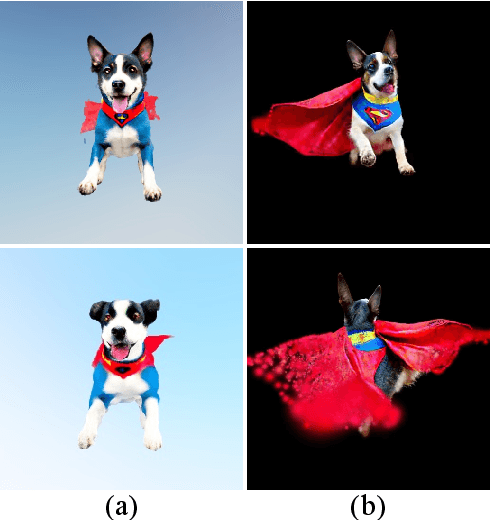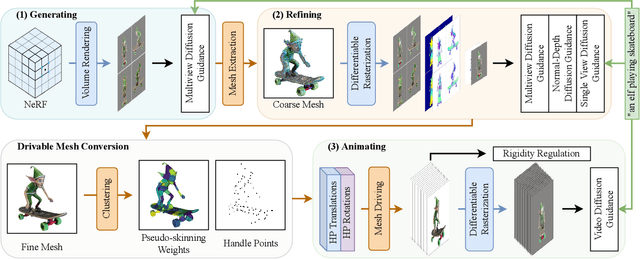Xuelin Chen
Democratizing High-Fidelity Co-Speech Gesture Video Generation
Jul 09, 2025Abstract:Co-speech gesture video generation aims to synthesize realistic, audio-aligned videos of speakers, complete with synchronized facial expressions and body gestures. This task presents challenges due to the significant one-to-many mapping between audio and visual content, further complicated by the scarcity of large-scale public datasets and high computational demands. We propose a lightweight framework that utilizes 2D full-body skeletons as an efficient auxiliary condition to bridge audio signals with visual outputs. Our approach introduces a diffusion model conditioned on fine-grained audio segments and a skeleton extracted from the speaker's reference image, predicting skeletal motions through skeleton-audio feature fusion to ensure strict audio coordination and body shape consistency. The generated skeletons are then fed into an off-the-shelf human video generation model with the speaker's reference image to synthesize high-fidelity videos. To democratize research, we present CSG-405-the first public dataset with 405 hours of high-resolution videos across 71 speech types, annotated with 2D skeletons and diverse speaker demographics. Experiments show that our method exceeds state-of-the-art approaches in visual quality and synchronization while generalizing across speakers and contexts.
CT4D: Consistent Text-to-4D Generation with Animatable Meshes
Aug 15, 2024



Abstract:Text-to-4D generation has recently been demonstrated viable by integrating a 2D image diffusion model with a video diffusion model. However, existing models tend to produce results with inconsistent motions and geometric structures over time. To this end, we present a novel framework, coined CT4D, which directly operates on animatable meshes for generating consistent 4D content from arbitrary user-supplied prompts. The primary challenges of our mesh-based framework involve stably generating a mesh with details that align with the text prompt while directly driving it and maintaining surface continuity. Our CT4D framework incorporates a unique Generate-Refine-Animate (GRA) algorithm to enhance the creation of text-aligned meshes. To improve surface continuity, we divide a mesh into several smaller regions and implement a uniform driving function within each area. Additionally, we constrain the animating stage with a rigidity regulation to ensure cross-region continuity. Our experimental results, both qualitative and quantitative, demonstrate that our CT4D framework surpasses existing text-to-4D techniques in maintaining interframe consistency and preserving global geometry. Furthermore, we showcase that this enhanced representation inherently possesses the capability for combinational 4D generation and texture editing.
CraftsMan: High-fidelity Mesh Generation with 3D Native Generation and Interactive Geometry Refiner
May 23, 2024Abstract:We present a novel generative 3D modeling system, coined CraftsMan, which can generate high-fidelity 3D geometries with highly varied shapes, regular mesh topologies, and detailed surfaces, and, notably, allows for refining the geometry in an interactive manner. Despite the significant advancements in 3D generation, existing methods still struggle with lengthy optimization processes, irregular mesh topologies, noisy surfaces, and difficulties in accommodating user edits, consequently impeding their widespread adoption and implementation in 3D modeling software. Our work is inspired by the craftsman, who usually roughs out the holistic figure of the work first and elaborates the surface details subsequently. Specifically, we employ a 3D native diffusion model, which operates on latent space learned from latent set-based 3D representations, to generate coarse geometries with regular mesh topology in seconds. In particular, this process takes as input a text prompt or a reference image and leverages a powerful multi-view (MV) diffusion model to generate multiple views of the coarse geometry, which are fed into our MV-conditioned 3D diffusion model for generating the 3D geometry, significantly improving robustness and generalizability. Following that, a normal-based geometry refiner is used to significantly enhance the surface details. This refinement can be performed automatically, or interactively with user-supplied edits. Extensive experiments demonstrate that our method achieves high efficacy in producing superior-quality 3D assets compared to existing methods. HomePage: https://craftsman3d.github.io/, Code: https://github.com/wyysf-98/CraftsMan
Taming Diffusion Probabilistic Models for Character Control
Apr 23, 2024



Abstract:We present a novel character control framework that effectively utilizes motion diffusion probabilistic models to generate high-quality and diverse character animations, responding in real-time to a variety of dynamic user-supplied control signals. At the heart of our method lies a transformer-based Conditional Autoregressive Motion Diffusion Model (CAMDM), which takes as input the character's historical motion and can generate a range of diverse potential future motions conditioned on high-level, coarse user control. To meet the demands for diversity, controllability, and computational efficiency required by a real-time controller, we incorporate several key algorithmic designs. These include separate condition tokenization, classifier-free guidance on past motion, and heuristic future trajectory extension, all designed to address the challenges associated with taming motion diffusion probabilistic models for character control. As a result, our work represents the first model that enables real-time generation of high-quality, diverse character animations based on user interactive control, supporting animating the character in multiple styles with a single unified model. We evaluate our method on a diverse set of locomotion skills, demonstrating the merits of our method over existing character controllers. Project page and source codes: https://aiganimation.github.io/CAMDM/
SweetDreamer: Aligning Geometric Priors in 2D Diffusion for Consistent Text-to-3D
Oct 04, 2023Abstract:It is inherently ambiguous to lift 2D results from pre-trained diffusion models to a 3D world for text-to-3D generation. 2D diffusion models solely learn view-agnostic priors and thus lack 3D knowledge during the lifting, leading to the multi-view inconsistency problem. We find that this problem primarily stems from geometric inconsistency, and avoiding misplaced geometric structures substantially mitigates the problem in the final outputs. Therefore, we improve the consistency by aligning the 2D geometric priors in diffusion models with well-defined 3D shapes during the lifting, addressing the vast majority of the problem. This is achieved by fine-tuning the 2D diffusion model to be viewpoint-aware and to produce view-specific coordinate maps of canonically oriented 3D objects. In our process, only coarse 3D information is used for aligning. This "coarse" alignment not only resolves the multi-view inconsistency in geometries but also retains the ability in 2D diffusion models to generate detailed and diversified high-quality objects unseen in the 3D datasets. Furthermore, our aligned geometric priors (AGP) are generic and can be seamlessly integrated into various state-of-the-art pipelines, obtaining high generalizability in terms of unseen shapes and visual appearance while greatly alleviating the multi-view inconsistency problem. Our method represents a new state-of-the-art performance with an 85+% consistency rate by human evaluation, while many previous methods are around 30%. Our project page is https://sweetdreamer3d.github.io/
C$\cdot$ASE: Learning Conditional Adversarial Skill Embeddings for Physics-based Characters
Sep 20, 2023



Abstract:We present C$\cdot$ASE, an efficient and effective framework that learns conditional Adversarial Skill Embeddings for physics-based characters. Our physically simulated character can learn a diverse repertoire of skills while providing controllability in the form of direct manipulation of the skills to be performed. C$\cdot$ASE divides the heterogeneous skill motions into distinct subsets containing homogeneous samples for training a low-level conditional model to learn conditional behavior distribution. The skill-conditioned imitation learning naturally offers explicit control over the character's skills after training. The training course incorporates the focal skill sampling, skeletal residual forces, and element-wise feature masking to balance diverse skills of varying complexities, mitigate dynamics mismatch to master agile motions and capture more general behavior characteristics, respectively. Once trained, the conditional model can produce highly diverse and realistic skills, outperforming state-of-the-art models, and can be repurposed in various downstream tasks. In particular, the explicit skill control handle allows a high-level policy or user to direct the character with desired skill specifications, which we demonstrate is advantageous for interactive character animation.
LivelySpeaker: Towards Semantic-Aware Co-Speech Gesture Generation
Sep 17, 2023



Abstract:Gestures are non-verbal but important behaviors accompanying people's speech. While previous methods are able to generate speech rhythm-synchronized gestures, the semantic context of the speech is generally lacking in the gesticulations. Although semantic gestures do not occur very regularly in human speech, they are indeed the key for the audience to understand the speech context in a more immersive environment. Hence, we introduce LivelySpeaker, a framework that realizes semantics-aware co-speech gesture generation and offers several control handles. In particular, our method decouples the task into two stages: script-based gesture generation and audio-guided rhythm refinement. Specifically, the script-based gesture generation leverages the pre-trained CLIP text embeddings as the guidance for generating gestures that are highly semantically aligned with the script. Then, we devise a simple but effective diffusion-based gesture generation backbone simply using pure MLPs, that is conditioned on only audio signals and learns to gesticulate with realistic motions. We utilize such powerful prior to rhyme the script-guided gestures with the audio signals, notably in a zero-shot setting. Our novel two-stage generation framework also enables several applications, such as changing the gesticulation style, editing the co-speech gestures via textual prompting, and controlling the semantic awareness and rhythm alignment with guided diffusion. Extensive experiments demonstrate the advantages of the proposed framework over competing methods. In addition, our core diffusion-based generative model also achieves state-of-the-art performance on two benchmarks. The code and model will be released to facilitate future research.
Example-based Motion Synthesis via Generative Motion Matching
Jun 01, 2023Abstract:We present GenMM, a generative model that "mines" as many diverse motions as possible from a single or few example sequences. In stark contrast to existing data-driven methods, which typically require long offline training time, are prone to visual artifacts, and tend to fail on large and complex skeletons, GenMM inherits the training-free nature and the superior quality of the well-known Motion Matching method. GenMM can synthesize a high-quality motion within a fraction of a second, even with highly complex and large skeletal structures. At the heart of our generative framework lies the generative motion matching module, which utilizes the bidirectional visual similarity as a generative cost function to motion matching, and operates in a multi-stage framework to progressively refine a random guess using exemplar motion matches. In addition to diverse motion generation, we show the versatility of our generative framework by extending it to a number of scenarios that are not possible with motion matching alone, including motion completion, key frame-guided generation, infinite looping, and motion reassembly. Code and data for this paper are at https://wyysf-98.github.io/GenMM/
Patch-based 3D Natural Scene Generation from a Single Example
Apr 26, 2023Abstract:We target a 3D generative model for general natural scenes that are typically unique and intricate. Lacking the necessary volumes of training data, along with the difficulties of having ad hoc designs in presence of varying scene characteristics, renders existing setups intractable. Inspired by classical patch-based image models, we advocate for synthesizing 3D scenes at the patch level, given a single example. At the core of this work lies important algorithmic designs w.r.t the scene representation and generative patch nearest-neighbor module, that address unique challenges arising from lifting classical 2D patch-based framework to 3D generation. These design choices, on a collective level, contribute to a robust, effective, and efficient model that can generate high-quality general natural scenes with both realistic geometric structure and visual appearance, in large quantities and varieties, as demonstrated upon a variety of exemplar scenes.
3D-Aware Object Goal Navigation via Simultaneous Exploration and Identification
Dec 01, 2022



Abstract:Object goal navigation (ObjectNav) in unseen environments is a fundamental task for Embodied AI. Agents in existing works learn ObjectNav policies based on 2D maps, scene graphs, or image sequences. Considering this task happens in 3D space, a 3D-aware agent can advance its ObjectNav capability via learning from fine-grained spatial information. However, leveraging 3D scene representation can be prohibitively unpractical for policy learning in this floor-level task, due to low sample efficiency and expensive computational cost. In this work, we propose a framework for the challenging 3D-aware ObjectNav based on two straightforward sub-policies. The two sub-polices, namely corner-guided exploration policy and category-aware identification policy, simultaneously perform by utilizing online fused 3D points as observation. Through extensive experiments, we show that this framework can dramatically improve the performance in ObjectNav through learning from 3D scene representation. Our framework achieves the best performance among all modular-based methods on the Matterport3D and Gibson datasets, while requiring (up to 30x) less computational cost for training.
 Add to Chrome
Add to Chrome Add to Firefox
Add to Firefox Add to Edge
Add to Edge